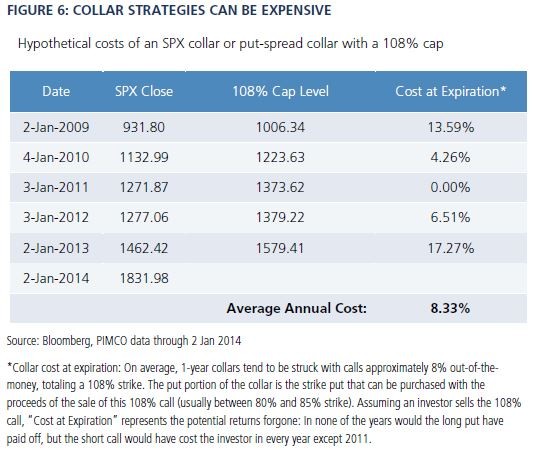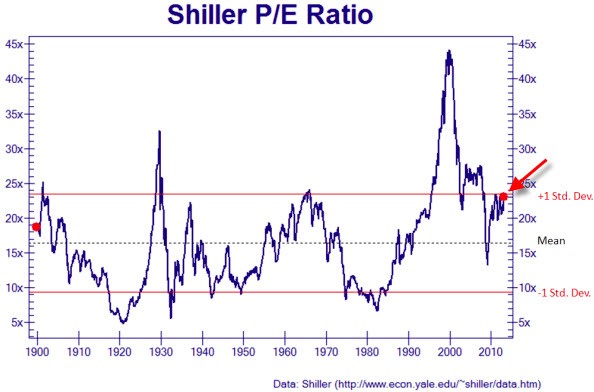PIMCO On Hedging It Pays To Be Countercyclical
Post on: 19 Сентябрь, 2015 No Comment

Authored by Vineer Bhansali of PIMCO,
Tail Risk Hedging: It Pays to Be Countercyclical
It is a well-known phenomenon that quiet markets, low volatility and a lack of visible risks on the horizon can lead to complacence and increasingly dangerous, leveraged positions. In doing so, these market conditions set the stage for the next cycle of deleveraging and losses. What has also become apparent is a predictable behavioral response to this cycle.
When the markets experience large losses, tail risk hedging comes back into fashion, leading to an old-fashioned surge in demand that drives up volatilities across markets. This in turn reduces the overall effectiveness of naïve hedges, and means one has to be smart about when and where to spend hedging premiums.
On the other hand, when markets are quiet, investors can quickly forget the pain suffered during prior crises. and may choose to eliminate the cost of tail hedging, or even more dangerously become sellers of tail hedges.
While no one really knows whether the future is going to result in more or less risk for markets, a quick look at the valuation levels for even the most vanilla of tail hedges shows us that we are back to the inexpensive levels we last saw prior to the financial crisis.
The table below is a historical comparison for direct tail risk hedges using SPX index put options going back to 2007: The conclusion is that even though skew (or difference in volatility between at-the-money and out-of-the-money tail hedges) is high, the cost of hedging in absolute terms is back to pre-crisis lows.
Investors should consider taking this opportunity to reload their hedges as soon as they can.
- The first column in the table is the year (using the same day eliminates any seasonal issues).
- The second column is the S&P 500 index level.
- The third column is the VIX (which is basically the weighted average of the whole volatility skew surface for short expiry options), a widely followed indicator of risk.
- In the fourth column we have the one-year, 25% out-of-the-money (OTM) volatility for a 25% OTM SPX put. We use 25% out-of-the-money volatility because a 15% OTM attachment point for a 60/40 (stocks/bonds) portfolio translates to a 25% direct SPX option.
- The next column is the 25% OTM strike price of an SPX option, currently at 1100.
- The skew to VIX, the sixth column, is still pretty high compared to the levels we saw in 2007 when the SPX was last near its current level (a 4% excess crash premium if you compare the 7% skew then to the 11% skew now).
- Finally, the next column shows the price of the 25% out-of-the-money SPX put option is currently at 1.42%, a post-crisis low.

When we scale this pricing for the 60/40 portfolio we get a “full-coverage” premium for what would generally be considered a naïve tail hedge of only 85 basis points (bps). In other words, a 60/40 portfolio can be hedged so there should not be downside beyond 15% for 85 bps for a one-year horizon.
This situation is not likely to last long. This is comparable to 1/15/2008, right before the crisis – although the volatility skew was flatter, out-of-the-money volatility was at roughly the same absolute level as it is today, so both the cost of the OTM put and the delta of the OTM hedge were roughly the same as they are today. For many investors, it paid to have tail hedges then. If investors believe we are still investing in a dangerous, potentially even more dangerous, environment, they should consider hedging.
Our discussion does not need to stop with buying volatility. There are many other markets that typically benefit from a falling VIX. Many credit markets have been direct beneficiaries of the belief in seemingly lower tail risks in equity markets, and could also end up suffering if there is a re-emergence of widespread fear of, and upward repricing of, these tails. The story runs pretty much in parallel for indirect hedges as well.
[ZH — perhaps that is what triggered some ‘cheap’ tail-risk hedging today?]
We believe that tail hedging is not just a trade, but an asset allocation decision for robust portfolio construction. In this light, today’s valuation levels make it easy to be countercyclical and add to tail hedges. Buy them at current attractive valuations.
[ZH: Valuations? — h/t @Not_Jim_Cramer]














